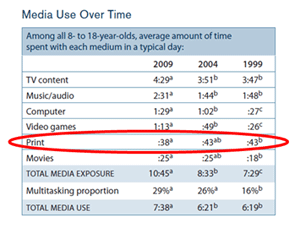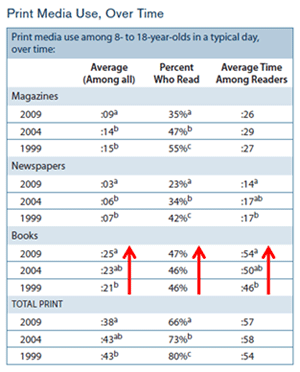NOTE: This is the third article in a 4-part series based on the Kaiser Family Foundation’s Generation M2:Media in the Lives of 8-18 Year-Olds. The first article is an overview of the report. The second article talks about how much “entertainment media” kids consume each day through music. This third article focuses on print media consumption, and the final article turns our attention to the undisputed heavyweight: the screen.
Reading. That time-consuming activity where one has to open a book, manually flip through page after page, and focus on…words?
Maybe that’s why so few kids are doing any of it these days.
Reduction in Reading
In Kaiser Family Foundation’s recently released 2009 report, Generation M2: Media in the Lives of 8-18-Year Olds, researchers continued their decade-long study on the “entertainment media” that kids consume on a daily basis. In part three of our promised series on their report, we’re taking a look at the “print media” (books, newspapers, magazines, etc.) that kids read these days. Bear in mind, the measurements only include the reading that kids did as entertainment; school-related reading is not a part of these findings.
 In their 2009 report, KFF found that consumption of every single form of entertainment media (TV, music, video games, etc.) increased…except reading. But that’s not really surprising, is it? They also found that reading for entertainment is the only media activity that decreases as the child grows older. Again, not surprising.
In their 2009 report, KFF found that consumption of every single form of entertainment media (TV, music, video games, etc.) increased…except reading. But that’s not really surprising, is it? They also found that reading for entertainment is the only media activity that decreases as the child grows older. Again, not surprising.
During the last 5 years, the total amount of time 8- to 18-year-olds spent reading books, magazines, and newspapers “for pleasure” dropped by 5 minutes per day…to 38 minutes each day. (In their 1999 and 2004 reports, that number was 43 minutes per day.) Other interesting findings include:
- About 10% of kids read newspapers and magazines online for about 21 minutes per day.
- On average, girls read about 10 minutes more per day than boys do.
- Heavy readers – kids who read an hour or more each day – were “substantially more likely to say they earn high grades” than light readers.
Shrinking Selection
A closer look at kids’ reading habits reveals that not all print media is created equal in their eyes. According to KFF, time spent reading “books” each day grew by several minutes. However, kids are reading far less “magazines” and “newspapers” these days. For instance, in 1999, 42% of the target group flipped through newspapers, but in 2009, only 23% did the same. In 1999, more than half of 8- to 18-year-olds (55%) read magazines, but in 2009, a mere 35% read them.
But then again, it’s hard for kids to read newspapers and magazines when they keep going out of business.
We’ve watched with keen interest as several newspapers and kid-centric magazines printed their last page in the past year and a half. Time has listed the Top 10 Most Endangered Newspapers in the country, and some of the more popular magazines that have gone extinct include CosmoGirl, Blender, Vibe, Teen, PC, and Electronic Gaming Monthly, just to name a few. The amount of materials that kids have been accustomed to reading seems to be shrinking a bit.
So, what’s left for kids to read?
Young Adult Fiction
Thanks to the likes of Stephanie Meyer and J.K. Rowling, kids have had plenty to read in recent years. These two female writers have supplied a generation of young readers with heroes and villains galore in a rapidly growing genre known as Young Adult Fiction (YAF).
Meyer’s The Twilight Saga focuses on vampires and werewolves who fall in love with humans in Forks, Washington, while Rowling’s Harry Potter series chronicles the adventures and trials of a young wizard at Hogwarts School of Witchcraft and Wizardry. Both of these franchises have been successful books that have turned into highly lucrative, full length, feature films. It was even recently announced that Twilight, the first book in The Twilight Saga, is getting its own graphic novel.
Authorities on the genre say that “dark fantasy” (like Twilight and Harry Potter) is one of the most popular elements of YAF. Publishers will be quick to chime in and agree; they’ve noticed – much to their delight – that teens are buying more books now than they have in decades.
 The impact of “books” on KFF’s research cannot be understated. As this chart clearly shows, were it not for kids’ book reading, the overall category of “print media” consumed would have dropped even more.
The impact of “books” on KFF’s research cannot be understated. As this chart clearly shows, were it not for kids’ book reading, the overall category of “print media” consumed would have dropped even more.
There are plenty of people who are speculating about the future of reading these days, especially after the recent announcement of Apple’s iPad. But those who are worried about students’ apparent apathy toward reading have good reasons to be concerned.
So, what – if anything – can be done to encourage kids to read more?
Hitting the Books
Anyone who even remotely enjoys reading understands the almost limitless benefits of reading: education, better health, new discoveries, etc.
There are several approaches parents can take if they want to get their kids reading more.
- Read yourself. As with everything else in life, nothing is as effective as leading by example. If you’re one of the 58% of adults who never reads a book after high school, grab one soon, and let your kid see you crack it open!
- Provide ample reading material. You might get them a subscription to a gaming magazine, or a sports periodical, etc. Chances are good they’ll read about what interests them. (I literally learned how to read by flipping through the book versions of the original Star Wars trilogy.)
- Do it together. Try reading the same book/article/magazine as your child so you can discuss it over a milkshake later. You might also find that visiting a cool bookstore together is fun. Hey, you go to Blockbuster together, right? Check out a Barnes & Noble or a Borders bookstore together, too.
- Monitor it. Of course, as with all media aimed at kids, you should monitor it. There are subtle messages buried in printed media that are just as suggestive as the messages hidden in music, movies, and TV shows.
Do all you can to encourage your teenagers to read. They will need your help when it comes to balancing their media consumption. Help them make sure they get some “page time” in each day in addition to all the music they’re listening to
David R. Smith
David R. Smith is the author of several books including Christianity... It's Like This and speaks to parents and leaders across the U.S. David is a 15-year youth ministry veteran, now a senior pastor, who specializes in sharing the gospel, and equipping others do the same. David provides free resources to anyone who works with teenagers on his website, DavidRSmith.org David resides with his wife and son in Tampa, Florida.



